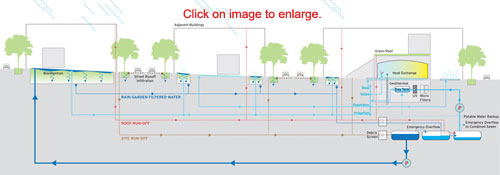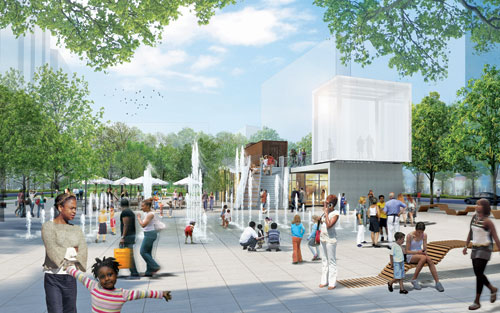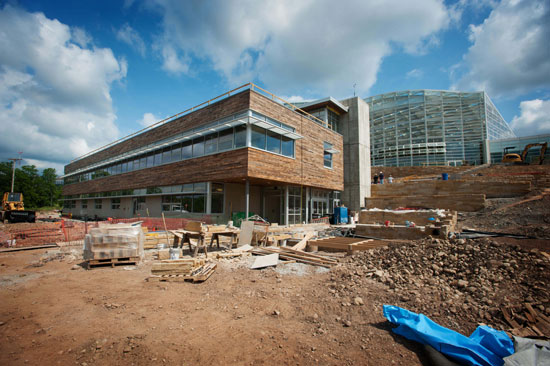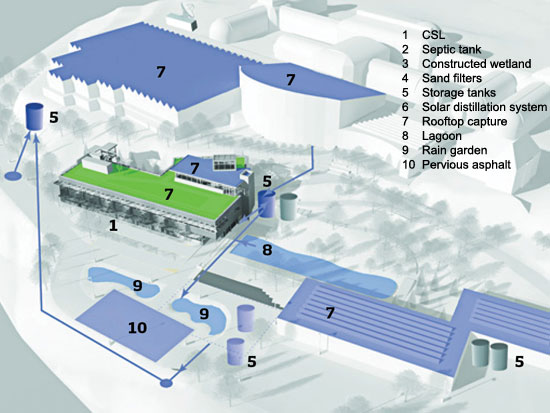Site Specific
Furthermore, Hunts Point Landing–which Nielsen believes is the most sustainable project on which she has ever worked–was not eligible for a significant portion of the total possible points because they call for the “maintenance, preservation, protection, or reuse of water features, plant communities, soils, and on-site materials.” According to Nielsen, at Hunts Point these elements either did not exist or were so contaminated that they had to be capped. She concludes that “ultra-urban brownfield sites are effectively penalized [by SITES] because they are wastelands to start with.”
Civil engineer Steve Benz, who is a partner in the Philadelphia office of OLIN, a landscape architecture firm, also struggled with this issue on another urban brownfield in the pilot program–the Washington Canal Park in Washington, D.C. A member of SITES’ technical core committee, he acknowledges that the initiative to date has primarily focused on the preservation of a site’s ecological capacity, which is typically of greater significance on less developed land, rather than on the sustainable challenges and realities of urban density.
“It’s more difficult to resolve how the current SITES system works in urban settings,” says Benz, who adds that the technical committee is learning about this and other “procedural disconnects” from the pilot program and is working on addressing these concerns.
A former chair of USGBC’s sustainable sites technical advisory group (TAG) who now serves on the organization’s water efficiency TAG, Benz hopes that the pilot program will shed light on the usability and practicality of SITES. He believes that LEED has been successful in terms of market penetration because the older rating system is well understood and achievable. However, he worries that the preliminary version of SITES may attract only a small number of projects because it asks for such high performance. To appeal to the broadest possible audience and generate the greatest positive impact, he says, “this currently highly rigorous rating system may have to lower its sights a bit.”
| Performance Based A Pittsburgh Botanical Garden Targets a Trio of Certifications By Joann Gonchar, AIA |
|||||
Among the more than 150 projects participating in the SITES pilot is the Center for Sustainable Landscapes (CSL) at the Phipps Conservatory and Botanical Gardens in Pittsburgh. The recently completed building, which houses the 119-year-old public garden’s educational and research programs and administrative offices, is seeking the highest level of SITES certification—four stars. In addition, the $14.5 million project is targeting a LEED Platinum rating as well as “Living Building” status. The latter designation is widely regarded as one of the toughest green building certifications to achieve. In order to satisfy the requirements of this rating system trifecta, the design team developed a “synthetic solution” in which the 24,000-square-foot CSL and the surrounding 2.65-acre site work as one, explains Chris Minnerly, principal of Pittsburgh-based The Design Alliance, the project’s architect. The building steps down with its steeply sloping site, has its long axis oriented east-west to minimize solar gain and a thermally robust exterior envelope with a skin of wood reclaimed from dismantled Pennsylvania barns. It will generate all of its own energy with photovoltaic panels, a vertical axis wind turbine, and geothermal wells. The landscape is still in the process of being installed, but once complete later this summer, it will include water features, native plant materials, and rain gardens. The scheme will do more than merely look good, says José Almiñana, a principal at Philadelphia-based Andropogon, the project’s landscape architect. “It will perform.”
One of the roles the landscape will play is helping the CSL satisfy all of its water needs (except for drinking water and a few other uses) without relying on external sources other than rainwater. The building and its environs will manage stormwater and treat wastewater. It will put these sources to use for toilet flushing and to offset the significant irrigation demands of the conservatory’s greenhouses. Phipps’s collection of orchids, for example, will be watered with graywater (water generated by the CSL’s lavatories) and blackwater (water from toilet flushing), but only after the effluent is cleansed in a number of on-site treatment steps that include a traditional septic system and a constructed wetland containing plants such as cattails and rushes chosen for their ability to strip the water of nutrients. A solar distillation system will provide the final purification step. A separate set of systems will collect rainwater from the CSL’s green roof and the roofs of neighboring buildings, directing it to a lagoon where hydrophytes (plants that thrive when submerged in water) will help remove the small amount of impurities found in roof runoff. After UV treatment, the water will be allowed to infiltrate into the ground or will be stored in cisterns for various non-potable uses on site. When completed, the lagoon will support full aquatic environments, providing a habitat for fish and insects. The lagoon, along with the constructed wetland, will transform the normally hidden, workaday processes of stormwater and wastewater management into landscape amenities that are completely independent of freshwater sources. |













